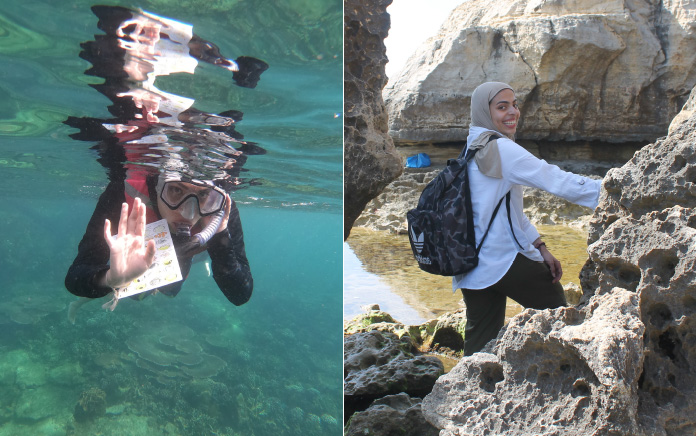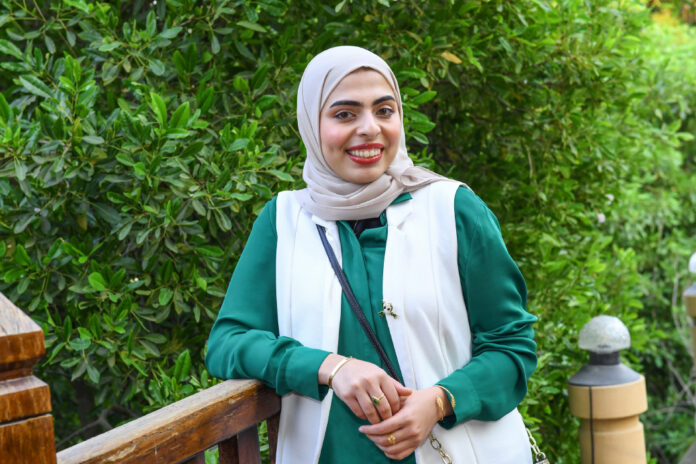Narjes Khalil has always had a tendency to compile information and eagerly document life around herself whether through photography or collecting information. These skills helped her in her professional journey, and have led her to being an Environmental Scientist and Curator of Budaiya Hub.
In this inspiring chat with Farah Baig, she talks about environmental projects in Bahrain and the impact of mangroves, and shares her advice for young women pursuing a career in the environmental field.
When did you first take an interest in environmental science?
My journey into environmental science all began with my interest in fiction. As a kid, I was obsessed with stories about magical worlds, strange creatures and breathtaking landscapes. It’s like that fascination and that sense of wonder morphed into how I see the real world today – as something equally magical. I look at nature, our environment and this big blue planet with the same awe and wonder for those childhood stories. My simple goal was, and still is, to keep learning about it all.
 What are some of the different environmental projects taking place in Bahrain?
What are some of the different environmental projects taking place in Bahrain?
I’d love to tell you about the exciting environmental projects happening right here in Bahrain. First and foremost, there’s the afforestation campaign that’s been making quite an impact. To explain, they’re planting trees that are well-suited to our environment; it’s not just about adding some greenery. These trees are strategically chosen to combat the urban heat island effect, attract birds and provide much-needed shade. Every time I drive around, I can’t help but look out for those distinctive green metal poles that mark the campaign’s progress.
Speaking of green initiatives, I’m really proud to mention a project we kicked off at the Budaiya Hub called ‘Find us at the Park’. The idea behind it was to get people out to our parks, engage them in fun activities and emphasise the importance of them as community spaces.
What’s even more exciting is that this pilot project has evolved into a collaboration with the UN-Habitat’s National Wide Afforestation Data Collection project. We’re working together to assess the needs of our parks and identify the best spots to plant more trees. It’s like a natural extension of the afforestation campaign, and I believe it’ll make a significant impact.
You have a special interest in mangroves. What makes them so special?
Mangroves hold a special place in my heart, and I’m really excited to share why they’re so important for our environment. Bahrain’s mangroves, the Avicennia Marina species, have given me something truly valuable – a sense of community with people who share a genuine passion for the environment.
What’s incredible about mangroves is how they demonstrate the interconnectedness of nature. These amazing coastal ecosystems have some remarkable qualities that make them stand out. For starters, they can absorb up to four times more carbon dioxide from the environment than tropical rainforests. So, they play a crucial role in helping combat climate change by reducing greenhouse gases. They are a bustling habitat for various species, from wintering birds to shrimp and fish.
So, when you see the lush mangroves here in Bahrain, it’s not just a beautiful sight; it’s a testament to the power of nature in bringing everything together – from ecological balance to human connection.
What can you tell us about Budaiya Hub and your role as its curator?
The Budaiya Hub is a group of young people that are part of the Global Shapers Community under the World Economic Forum working on projects which aim to make a positive change in the community. The shapers in Budaiya Hub are an amazing and inspiring group and I continue to learn from each and every one of them – I truly feel blessed to be around and part of such an amazing community.
Taking on the role at the Budaiya Hub has been quite the journey. I was approached last year to join as the vice curator, following a recommendation from someone, who I am grateful for, which prompted the offer. It was an entirely new experience for me, but I knew deep down that I wanted to challenge myself and embrace something entirely different – so it was an instant ‘yes’.
This year, when I was voted into the role of curator, it was another unexpected turn. I’ll admit that I had some initial concerns, but I also had a clear goal in mind – to create a space where young people can connect, share their ideas and simply have a great time. If I can inspire at least one person during my time in this role, I’ll consider it a success.
 How did you pursue your environmental career academically?
How did you pursue your environmental career academically?
I have been blessed with the opportunity to study environmental science. I earned my Bachelor’s degree from the University of Portsmouth, where I really honed my research skills. We delved into everything from terrestrial and freshwater habitats to environmental monitoring techniques.
During my studies, I discovered a strong interest in biodiversity. Especially after the fieldwork I conducted across the UK, Malta and Malaysia. Those experiences solidified my passion for understanding and protecting biodiversity.
Do you have any advice for young women wishing to pursue a career in the environmental field?
Start by actively working towards your goal. Take charge of your path. Invest in your education and skills. If you don’t have the access to study the degree you are aiming for, connect the dots that will lead you there. Consider enrolling in environmental courses online, document what you see and learn on the field. Acknowledge and appreciate the work that has already been done around you, and carry on from there.
Remember that effort and hard work truly pay off. But here’s a secret: do it with a light heart. Don’t take yourself too seriously. Enjoy the journey – it’s much more fun and rewarding that way.
In the end, you’ve got to take that first step. Dive into the world of environmental conservation with enthusiasm, and you’ll find that it’s a journey worth every moment.
What advice would you give our readers so that they may lead a sustainable life?
When it comes to leading a more sustainable life, my advice is to start by thinking locally. It’s one of the most effective approaches we can adopt. Consider buying locally sourced and seasonal products. Embrace the timeless mantra of ‘reduce, reuse, recycle’ and seek out local initiatives that promote sustainability.
I’d also like to offer a piece of advice that’s close to my heart: take the time to truly explore your surroundings. Discover the wonders right in your own backyard. Observe the types of trees that surround you and pay attention to the specific bird species that visit. It’s truly fascinating what you can uncover when you start looking closely.
Is there anything else you would like to add?
I think, especially for those in this field or interested in this field, who grow up with the feeling of wanting to save the world. Don’t lose that – it is a beautiful belief. Don’t lose sight of the fact that we are guardians, custodians and caretakers of this Earth.
But remember that while we can save the world, we can’t do it alone. It’s a group effort. It’s not one action, one piece of work you do, that will tackle biodiversity loss. It’s a combination of so many different efforts.
In the Quran, there’s a verse that beautifully illustrates our role as stewards of the environment:
(And He it is who has made you successors upon the Earth). We must embody this responsibility.
Lastly, be honest and authentic in your environmental work. Do it with credibility and a commitment to doing it right. Trust that others will do the same.





